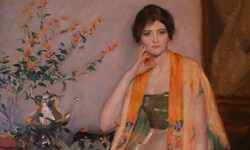[ccfic caption-text format="plaintext"]
By James Kinneen
Hometown Weekly Reporter
The Wellesley Historical Society has a ton of cool items, and not a whole lot of space to show them off. To try and remedy this issue, the society has begun holding a monthly “show and tell,” during which they bring in one of their historical items, discuss its history and value as an educational resource, and provide insight into how it is stored and how it ended up in the society’s possession.
This month, archivist and collections manager Taylor Kalloch chose to bring an oil painting by former Wellesley resident Mary Brewster Hazelton. The painting, titled “Nina Rubinoff” after the model it depicts, was created at the Fenway studio that Hazelton founded after studying at the School of the Museum of Fine Arts under Edmund Tarbell. When the Wellesley Historical Society was looking to have the painting renovated (it had a slice in it, as well as some other issues), they hired a man working out of the same building in which Hazelton painted it.
“It was nice that the painting kind of got to go home” Kalloch explained to the crowd.
Kalloch also explained why the painting didn’t have a frame - though there is more than one reason this tends to happen with old oil paintings. While Kalloch acknowledged not having heavy frame made it easier for her to transport, she made sure audience members understood that oil paintings don’t need glass protection, as they are not as fragile as watercolor paintings. Watercolors, on the other hand, are so fragile that in her office, she needs to cover them in black sheets to keep them away from the sun.
“If you come to my office, some days you will think there’s a funeral going on,” she joked.
Another reason is that sometimes the frames are worth more than the paintings. It was unclear if that was the case with the painting (which was donated to the society by a private citizen in 1986), but Kalloch noted that for its replacement, she wanted a frame from around the same time that the painting was created - or as she put it, “a frame sympathetic to the time period.”
Kalloch had a variety of images on hand, which showed the painting before it was renovated. So, once her presentation was done and she had fielded a variety of questions, a large crowd gathered to compare the work with what it had looked like before.
The piece and its compelling history were interesting enough to fill the hour, and to keep people coming back to see what else the Historical Society has to show them.
























